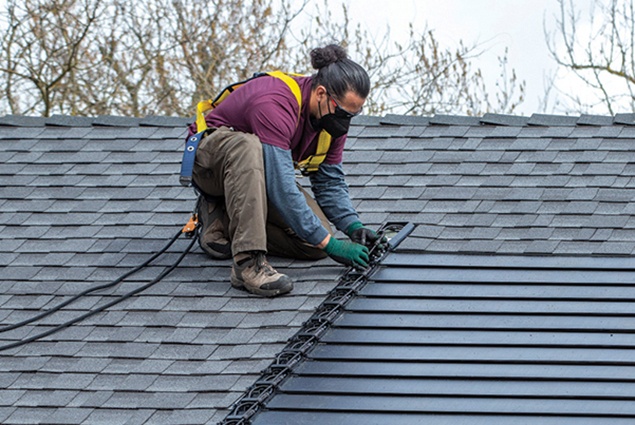Roof with solar panels, such as GAF Energy’s Solar Shingle, is becoming increasingly popular due to their environmentally friendly solution and cost savings on electricity bills.
In this comprehensive blog post, we will delve into various aspects of systems of roof-top solar such as GAF Energy’s Solar Shingle, which offers both aesthetic appeal and lower installation costs. We will also explore the potential for roof with solar panels to meet U.S. electricity demands while addressing affordability challenges.
Furthermore, you’ll gain a deeper understanding of solar shingle that seamlessly blend photovoltaic cell technology with functionality. Additionally, we’ll discuss cost considerations including price range estimates and financial incentives driving adoption.
You can expect insights on how shading factors affect performance levels and the importance of proper placement for optimal results. Lastly, we will touch upon the benefits of installing solar panels on metal roofs by leveraging standing seam technology that combines sustainability with style.
By examining the discussed topics in detail, you’ll be ready to make wise decisions when evaluating a roof with solar panels for your domestic or commercial endeavor.
Table of Contents:
- GAF Energy’s Solar Shingles
- Lowering Rooftop Solar Costs
- Aesthetically Pleasing Design
- The Potential of Rooftop Solar
- Understanding Solar Shingle
- Cost Considerations
- Savings Through Solar Panels
- Shading Factors Affecting Performance
- Solar Panels on Metal Roofs
- Standing Seam Technology Benefits
- Combining Sustainability with Style
- FAQs in Relation to Roof With Solar Panels
- Conclusion
GAF Energy’s Solar Shingle
As the demand for alternative energy (renewable) sources grows, innovative solutions like GAF Energy’s solar shingle are becoming increasingly popular. These unique roofing materials not only provide an aesthetically pleasing design but also help lower roof with solar panels’ costs by about $14,000.
As a sibling company of GAF, one of the largest roofing manufacturers in North America, GAF Energy aims to make sustainable living more accessible with its groundbreaking product.
Lowering Roof With Solar Panels’ Costs
By providing a single installation process for both roofing and solar, GAF Energy’s solar shingle makes it easier to access sustainable living while saving on costs. By combining both roofing and processes to install solar panels into one seamless procedure, these innovative tiles can reduce overall project costs significantly compared to traditional methods involving separate contractors for each task.
Aesthetically Pleasing Design
In addition to cost savings, another advantage offered by GAF Energy’s solar shingle is its visually appealing appearance that closely resembles traditional roof materials. This allows property owners to maintain a cohesive look throughout their building without sacrificing functionality or efficiency. Furthermore, these durable glass tiles come with a 25-year warranty and will soon be available nationwide after launching on the East Coast.
- Solar panels: Harnessing sunlight as an alternative energy (renewable) source through photovoltaic cells embedded within glass tiles.
- Solar roof: A combination of conventional roofing materials and integrated solar technology designed for maximum aesthetic appeal and efficient power generation.
- Roof-top solar: The process of installing specialized equipment such as panels or shingles directly onto existing roof structures to generate electricity from sunlight.
- Solar shingle: A type of solar roof that closely resembles traditional roofing materials, offering a visually pleasing design while generating clean energy for the building’s occupants.
With GAF Energy’s innovative approach to roof-top solar solutions, more individuals and businesses can now enjoy the benefits of energy that can be renewed without compromising on style or budget. As these products become increasingly accessible, it is likely that we will see even greater adoption rates among homeowners and professionals alike in pursuit of sustainable living practices.
GAF Energy’s Solar Shingles present an attractive, cost-efficient answer to roof-top solar energy requirements, making them a great selection for both residential and commercial users.
In order to meet the U.S.’s electricity needs, it is essential to investigate solutions that can address cost obstacles and make roof with solar panels more attainable. electricity demands, it is important to explore solutions that can overcome affordability challenges in order to make this technology more accessible.
Key Takeaway:
GAF Energy’s solar shingles are an innovative roofing material that provides a visually appealing design while reducing roof with solar panels’ costs.
By combining both roofing and solar installation processes into one, these tiles can significantly lower overall project expenses compared to traditional methods involving separate contractors for each task. With their groundbreaking product, GAF Energy aims to make sustainable living more accessible and attractive for homeowners and businesses alike.
The Potential of Roof With Solar Panels
Roof with solar panels on small buildings has the potential to meet up to a quarter of electricity demand in the United States. However, it hasn’t been easy or affordable for many homeowners.

With new products like GAF Energy’s solar shingles entering the market, this eco-friendly alternative is becoming more accessible for those concerned about their carbon footprint and energy expenses.
Meeting U.S. Electricity Demands
According to a study by the National Renewable Energy Laboratory (NREL), rooftop solar systems could generate as much as 1,118 gigawatts of power annually – enough to cover around 24% of total U.S. electricity consumption. This demonstrates that harnessing energy sources such as sunlight can significantly contribute towards reducing dependency on fossil fuels and promoting sustainability.
Overcoming Affordability Challenges
In the past, installing roof with solar panels were often an expensive endeavor with long payback periods that deterred many homeowners from adopting this green technology. Recent developments in photovoltaic technology have seen great reductions in costs and heightened efficiency – allowing for greater adoption of this green tech by households across the US.
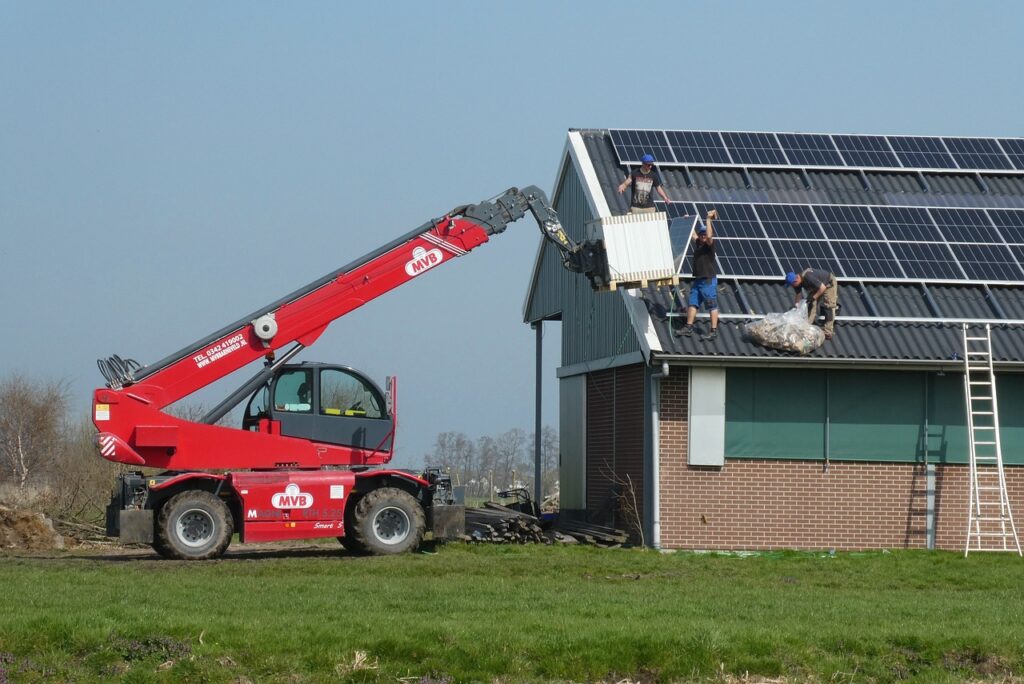
- Solar installation companies: The growing number of solar companies has resulted in competitive pricing structures which ultimately benefit consumers looking for affordable options.
- Federal tax credits: Homeowners who install solar panels are eligible for federal tax credits under the Investment Tax Credit (ITC) program which helps offset the initial investment costs.
- State incentives: Many states offer additional financial incentives, such as rebates and grants, to encourage residents to adopt solar energy systems in their homes.
Roof with solar panels is increasingly becoming a feasible choice for those wishing to cut their carbon footprint while trimming energy expenses, due to the mix of incentives available. The introduction of innovative products like GAF Energy’s solar shingles further expands accessibility by offering aesthetically pleasing solutions that seamlessly integrate with existing roof designs.
Roof with solar panels has vast potential, and with the proper mix of tech and incentives it could be a feasible way to meet US energy needs soon. electricity demands in the near future. To further explore this possibility, we must understand how solar roof shingles work to blend aesthetics with functionality.
Key Takeaway:
Roof with solar panels has the potential to meet up to a quarter of electricity demand in the United States, but affordability has been an issue for many homeowners. However, recent advancements in photovoltaic technology and financial incentives such as federal tax credits and state grants are making it more feasible for households across America.
Understanding Solar Shingle
A solar shingle is an innovative and eco-friendly alternative to traditional roofing materials. They not only provide a sleek, modern appearance but also harness the power of sunlight to generate electricity for your home.
In this part, we’ll investigate how solar shingle function, their advantages and why they could be the ideal decision for your next roof venture.
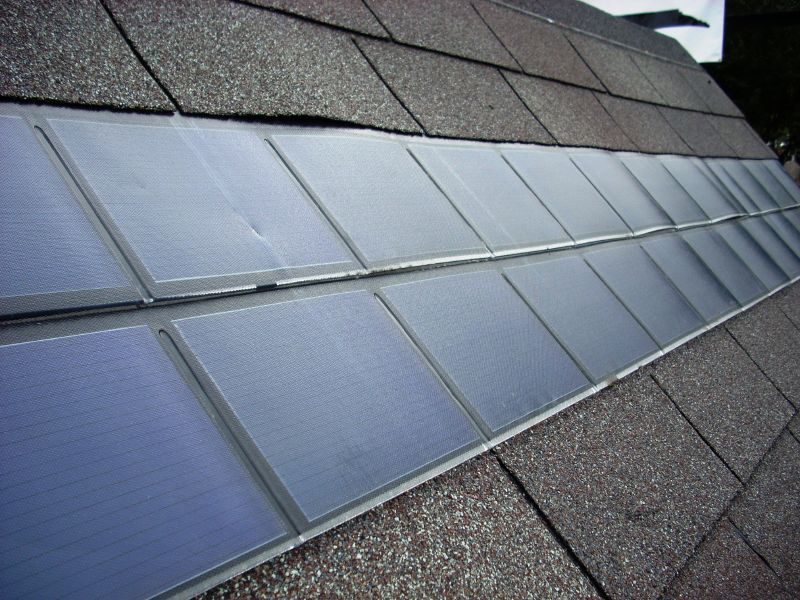
Photovoltaic Cell Technology
The main element of solar shingle is the photovoltaic cell, or PV cell. When light particles (photons) hit the PV cell, they create an electric current through a phenomenon known as the photovoltaic effect.
When light particles (photons) strike the surface of a PV cell, they knock electrons loose from their atoms. This movement of electrons generates an electric current that can be used to power your home’s appliances and lighting systems.
Blending Aesthetics with Functionality
One major advantage of solar shingle is their ability to blend seamlessly with other roofing materials while still providing energy generation capabilities.
Unlike bulky roof with solar panels that can detract from a building’s appearance, GAF Energy’s solar shingles, for example, closely resemble traditional asphalt shingle designs and colors. This allows homeowners and architects alike to maintain aesthetic consistency without sacrificing functionality.
- Durability: A solar shingle is designed to withstand harsh weather conditions such as hailstorms or high winds just like conventional roofing materials do; in fact, some manufacturers offer warranties up to 25 years ensuring long-lasting performance.
- Fire Resistance: Many solar shingles have been tested and rated for fire resistance, providing an added layer of safety for your home. This is especially important in areas prone to wildfires or where building codes require specific fire ratings on roofing materials.
In addition to their visual appeal and durability, solar shingle roof also contribute to reducing your carbon footprint by generating energy – clean and renewable. By installing these innovative tiles on your rooftop, you can take a significant step towards a more sustainable future while enjoying the benefits of lower electricity bills and increased property value.
Before opting for solar shingles roof, it is essential to evaluate the financial implications of this choice. Next, let’s evaluate the financial elements of incorporating solar shingles roof into a home.
Key Takeaway:
Solar shingle is a modern and eco-friendly alternative to traditional roofing materials that harness the power of sunlight to generate electricity for your home. They use photovoltaic cell technology, blend seamlessly with other roofing materials, and offer durability and fire resistance while contributing to reducing your carbon footprint.
Cost Considerations
When contemplating the installation of solar shingle, it is important to factor in their associated costs which range from $21-$25 per square foot or around $2,100-$2,600 per roofing square; yet financial incentives have helped make them more affordable.

The price for these innovative tiles typically ranges between $21-$25 per square foot or around $2,100-$2,600 per roofing square. However, various financial incentives have helped drive down prices and make them more accessible for homeowners looking to save on energy bills while reducing their environmental impact.
Price Range Estimates
The amount of money needed to set up solar panel systems may differ, depending on a variety of elements such as location, system size and labor expenses.
While traditional roof with solar panels installations may be less expensive upfront than solar shingles, GAF Energy’s new product aims to lower overall costs by combining roofing and solar installation into one process. This approach could potentially save homeowners up to $14,000 when compared with separate installations.
Financial Incentives Driving Adoption
To further encourage the adoption of alternative energy (renewable) sources like solar power, there are numerous federal tax credits and state-level incentives available for those who choose to install solar panels or shingles on their homes. For example:
- Federal Solar Investment Tax Credit (ITC): This credit allows homeowners who install qualifying residential solar before December 31st, 2023 an opportunity to claim a deduction equaling 26% off total project costs from their federal income taxes.
- State-Level Rebates: In addition to federal tax credits, state-level rebates can further reduce the cost of solar installations. These incentives vary by state and may include cashback offers, property tax exemptions, or sales tax exemptions on equipment purchases.
- Net Metering: Many states offer net metering, which allows homeowners to sell excess energy generated by their system back to the grid at retail rates. This can help offset installation costs and lower monthly utility bills even more.
Exploring financial benefits can make the incorporation of photovoltaic roofing tiles a more realistic prospect for those wanting to use alternative energy (renewable) while also enhancing their house’s look and performance.
Weighing up the expenditure involved in setup and upkeep, it is essential to be aware of all components of the installation of solar panels on a roof prior to making a determination. Let’s explore the potential for savings that can be realized through solar panel technology.
Key Takeaway:
Solar shingle are an eco-friendly alternative to traditional roofing materials that can help homeowners save on energy bills and reduce their environmental impact. While the cost of installation may seem high, financial incentives such as federal tax credits and state-level rebates make it a more accessible option for those looking to embrace renewable energy.
Savings Through Solar Panels
Installing energy-efficient solar panels on your roof can lead to significant savings by reducing energy costs anywhere from 40% up to 60%. However, there are some drawbacks associated with using this technology that homeowners should be aware of before making the decision to invest in a roof with solar panel.
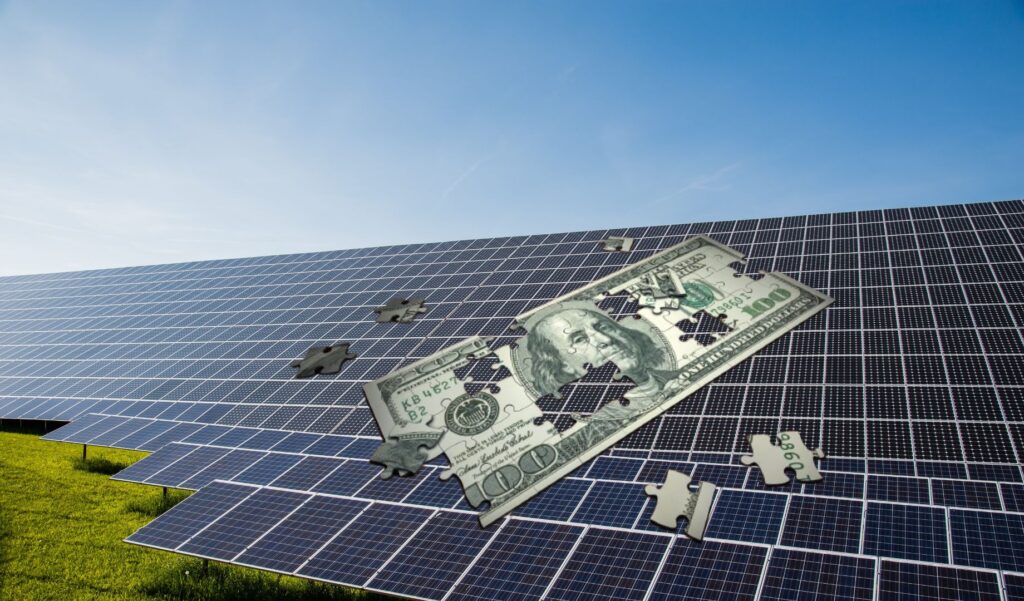
Energy Cost Savings
The primary benefit of the installation of solar panels is the potential for substantial reductions in your monthly electricity bills.
As more and more people turn towards energy sources – the renewable ones, such as roof-top solar systems, they not only save money but also contribute positively towards environmental conservation efforts.
Recent studies suggest that a solar panel system can result in cost savings of up to $30,000 over its lifetime for the average household.
- Lower utility bills: By generating your own electricity through solar power, you reduce dependence on grid-supplied electricity which results in lower monthly utility bills.
- Tax credits and incentives: Many states offer tax credits or rebates for homeowners who install renewable energy systems like solar panels. These financial incentives help offset installation costs while promoting sustainable living practices.
- Increase property value: Homes equipped with modern rooftop solar installations tend to have higher resale values compared to those without them due to increased demand among eco-conscious buyers looking for greener housing options.
Drawbacks and Challenges
No solution is perfect; therefore it’s essential for homeowners considering investing in a roof-top solar to be informed about potential drawbacks and challenges. One potential issue with solar panels is the difficulty of maintaining proper temperature, which can diminish performance and make it harder for homes to remain cool in warm weather.
Another challenge faced by homeowners looking to install solar panel systems on their roofs is finding reputable solar companies. It’s crucial to research and compare different providers in your area before making a decision, as this can significantly impact the quality of workmanship, customer service, and overall satisfaction with your investment.
Overall, a solar panel can be a great way to save money on energy costs if properly placed and maintained. Still, shading must be taken into account to guarantee the system works at its best.
Key Takeaway:
Installing a solar panel on your roof can lead to significant energy cost savings of up to 60%, with an average household saving between $10,000 and $30,000 over the lifetime of their system.
However, homeowners should be aware of potential drawbacks such as heat management issues and the importance of finding reputable installation companies before making a decision.
Shading Factors Affecting Performance
When installing solar panels, the effect of any shading should be considered as it can have a significant impact on their efficiency. Shaded areas on your property might not produce enough electricity compared with sunnier spots, where traditional panel systems would perform better overall due to increased exposure to sunlight throughout the day (although both types still generate less power than conventional methods).
Importance of Proper Placement
To maximize the efficiency and effectiveness of your solar system, proper placement is crucial.
When planning a roof-top solar installation, consider any potential obstructions such as trees or neighboring buildings that could cast shadows on your panels during peak sunlight hours. It’s also important to evaluate seasonal changes in sun angle and position, which can affect how much energy your panels will be able to generate.
Alternative energy (renewable) experts recommend conducting a site assessment before installing solar panels so you can identify any issues related to shading and determine the best location for optimal performance.
Comparing Performance Levels
- Sunny locations: In areas with abundant sunshine year-round, roof-top solar installations tend to have higher levels of efficiency because they receive more direct sunlight throughout the day.
- Moderate shade: If some parts of your roof are shaded during certain times but receive adequate sunlight at other times, it may still be worth investing in a solar panel system. However, keep in mind that output will likely be lower compared with fully sunny locations.
- Heavy shade: For properties with significant shading issues, it may be more beneficial to explore alternative energy (renewable) options such as wind turbines or consider installing a solar panel on a ground-mounted system away from obstructions.
In conclusion, understanding the impact of shading factors on your roof with solar panels installation is essential for maximizing efficiency and return on investment. By carefully evaluating your property’s unique characteristics and working with experienced solar installation companies, you can make an informed decision about whether a solar panel is the right choice for your home or business.
Shading considerations are an important element in achieving the best results from these systems, and it is vital to make sure that they are situated properly for peak performance. Moving on from this topic, we will now discuss how metal roofs can be combined with sustainability and style when installing a solar panel.
Key Takeaway:
When installing a solar panel on your roof, it’s important to consider shading factors that may affect their performance. Proper placement is crucial for maximizing efficiency and effectiveness, so conducting a site assessment before installation can help identify any issues related to shading and determine the best location for optimal performance.
Solar Panel on Metal Roofs
For those who want an environmentally-friendly solution without compromising aesthetics or durability but worry about undertaking major construction projects like installing large-scale panel arrays atop their existing structures – fear no longer. There are now options available for installing a solar panel on metal roofs using standing seam technology, ensuring a strong and stable installation.
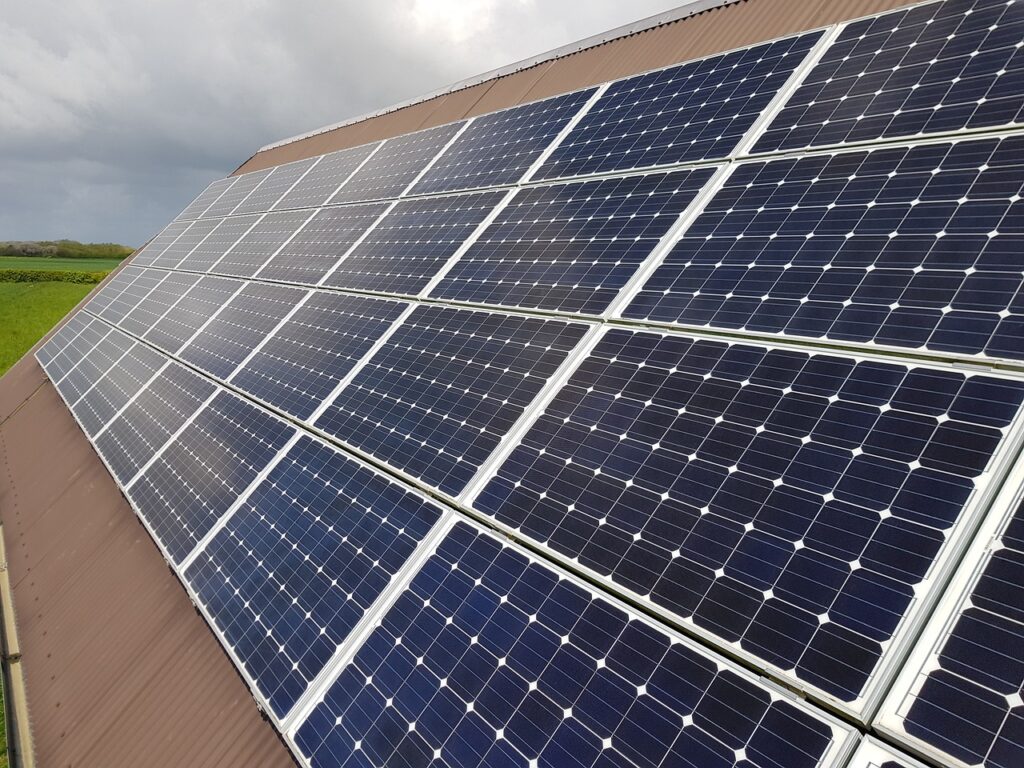
Standing Seam Technology Benefits
Solar panel systems installed on metal roofs with standing seam technology offer numerous advantages. This method of attachment does not require any penetrations to the roof surface, preserving its integrity and reducing the risk of leaks.
The clamps used in this system securely fasten the solar panel to the raised seams of a metal roof, providing increased wind resistance compared to traditional mounting methods.
In addition, solar energy systems mounted on metal roofs can benefit from improved heat management due to natural air circulation beneath the panels. This helps maintain optimal performance levels while also keeping your home cooler during the hot summer months.
Combining Sustainability with Style
- Aesthetics: A solar panel installed on metal roofs blend seamlessly into your property’s design without detracting from its appearance. Many homeowners find that these installations enhance their curb appeal.
- Durability: Metal roofing materials are known for their longevity and ability to withstand harsh weather conditions. When combined with high-quality solar panel backed by reputable companies involved in solar installation, you can expect a long-lasting and low-maintenance solution for your energy needs.
- Efficiency: The reflective properties of metal roofs can increase the efficiency of a solar panel by reflecting sunlight back onto them. This additional exposure to sunlight helps maximize the amount of electricity generated by your roof with solar panels.
Incorporating solar panels on metal roofs is an excellent way to harness alternative energy (renewable) while maintaining a stylish and durable exterior. By choosing this innovative approach, homeowners can enjoy the benefits of reduced energy costs, increased property value, and minimized environmental impact without compromising on aesthetics or functionality.
Key Takeaway:
A solar panel can be installed on metal roofs using standing seam technology, which offers several benefits such as preserving the roof’s integrity and increasing wind resistance.
This combination of sustainability and style provides a long-lasting, low-maintenance solution for energy needs while enhancing curb appeal and maximizing electricity generation.
FAQs in Relation to Roof With Solar Panels
Are Solar Panels on Your Roof a Good Idea?
Solar panels are an excellent choice for homeowners looking to save on energy costs and reduce their carbon footprint. They can significantly lower electricity bills. Additionally, many governments offer financial incentives for installing solar panels, making them more affordable than ever before.
How Do Solar Panels Affect the Life of Your Roof?
Properly installed solar panels can actually extend the life of your roof by protecting it from weather elements such as rain, snow, and UV rays. However, improper installation or poor-quality materials may cause damage over time. It’s essential to work with experienced professionals when adding solar panels to ensure longevity.
What Are the Drawbacks of Solar Shingles?
While aesthetically pleasing and functional, there are some drawbacks to using solar shingles instead of traditional rooftop-mounted systems: they tend to be less efficient in converting sunlight into electricity; they’re generally more expensive; and replacing damaged or malfunctioning shingles can be challenging due to their integrated design.
How Long Do Solar Panels Last on a Roof?
Solar panel lifespan typically ranges between 25-30 years but depends on factors like quality of materials used during the manufacturing process & local climate conditions affecting performance over time. Most manufacturers also offer warranties covering defects & power output degradation within this period.
If you’re considering installing solar panels on your roof, it’s important to research solar companies and solar companies in your area. Look for experienced professionals who use high-quality materials and offer warranties on their work. With the right solar structure, you can enjoy clean, alternative energy (renewable) and significant savings on your energy bills for years to come.
Roof with Solar Panel: A Recap
In conclusion, roof with solar panels have a multitude of benefits. GAF Energy’s Solar Shingles offer an aesthetically pleasing design while lowering rooftop solar costs.
Utilizing rooftop solar technology can help meet the electricity demands of the U.S., and increase affordability levels. electricity demands and overcome affordability challenges.
It is crucial to understand the technology behind photovoltaic cells and proper placement to maximize energy cost savings and performance levels. While there are some drawbacks and shading factors to consider, combining sustainability with style through standing seam metal roofs is another option to explore.
If you’re interested in learning more about installing solar panels on your roof, visit myrooff.com for resources on solar installation companies, cost considerations, and more.

